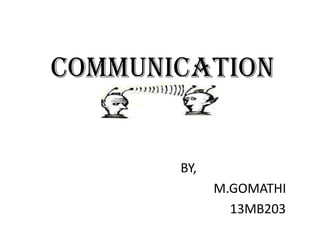Report
Share

More Related Content
What's hot
What's hot (20)
Job satisfaction Research based project-presentation

Job satisfaction Research based project-presentation
Viewers also liked
Viewers also liked (12)
Similar to Ob communication
Similar to Ob communication (20)
Recently uploaded
Recently uploaded (20)
Boost Fertility New Invention Ups Success Rates.pdf

Boost Fertility New Invention Ups Success Rates.pdf
Apidays New York 2024 - Passkeys: Developing APIs to enable passwordless auth...

Apidays New York 2024 - Passkeys: Developing APIs to enable passwordless auth...
Modular Monolith - a Practical Alternative to Microservices @ Devoxx UK 2024

Modular Monolith - a Practical Alternative to Microservices @ Devoxx UK 2024
ProductAnonymous-April2024-WinProductDiscovery-MelissaKlemke

ProductAnonymous-April2024-WinProductDiscovery-MelissaKlemke
Web Form Automation for Bonterra Impact Management (fka Social Solutions Apri...

Web Form Automation for Bonterra Impact Management (fka Social Solutions Apri...
Rising Above_ Dubai Floods and the Fortitude of Dubai International Airport.pdf

Rising Above_ Dubai Floods and the Fortitude of Dubai International Airport.pdf
CNIC Information System with Pakdata Cf In Pakistan

CNIC Information System with Pakdata Cf In Pakistan
How to Troubleshoot Apps for the Modern Connected Worker

How to Troubleshoot Apps for the Modern Connected Worker
Apidays New York 2024 - APIs in 2030: The Risk of Technological Sleepwalk by ...

Apidays New York 2024 - APIs in 2030: The Risk of Technological Sleepwalk by ...
Repurposing LNG terminals for Hydrogen Ammonia: Feasibility and Cost Saving

Repurposing LNG terminals for Hydrogen Ammonia: Feasibility and Cost Saving
TrustArc Webinar - Unlock the Power of AI-Driven Data Discovery

TrustArc Webinar - Unlock the Power of AI-Driven Data Discovery
Vector Search -An Introduction in Oracle Database 23ai.pptx

Vector Search -An Introduction in Oracle Database 23ai.pptx
AWS Community Day CPH - Three problems of Terraform

AWS Community Day CPH - Three problems of Terraform
Six Myths about Ontologies: The Basics of Formal Ontology

Six Myths about Ontologies: The Basics of Formal Ontology
Ob communication
- 2. COMMUNICATION “Communication is the transfer of information from one person to another person . It is way of reaching others by transmitting ideas, thoughts, feelings and values.” - Newstorm and Davis.
- 3. COMMUNICATION – IN OB • Communication is the process through which two or more persons come to exchange ideas and understanding among themselves. • It has 3 aspects. - it must have subject. - sender must consider the receiver. - understanding in the same sense.
- 4. COMMUNICATION PROCESS • It is a dynamic ,continuous and flexible. • There are three types of models . - Shannon weaver model. - Berro model. - Transactional process model.
- 7. SIGNIFICANCE • • • • • • It is essence of social behavior. It helps to control the behavior of the group. It fosters motivation. To share their feelings in the organization. It helps in decision making. It helps to change the people’s attitude.
- 8. COMMUNICATION TYPES TYPES OF COMMUNICATION INTERPERSONAL ORAL ORGANIZATIONAL WRITTEN NON VERBAL
- 9. BARRIERS TO EFFECTIVE COMMUNICATION • Sender related barriers • Situational related barriers. • Receiver related barriers.
- 10. SENDER RELATED BARRIERS • • • • • • • • Communication goals Communication skills Interpersonal sensitivity Differing frame of experience Improper diction Inconsistent non verbal signals Fear Sender’s credibility.
- 11. RECEIVER RELATED BARRIERS • • • • • Selective and poor listening Evaluating source Perception Lack of responsive feedback Metacommunication
- 12. SITUATIONAL RELATED BARRIERS • • • • • • • Jargon Information overlaod Time pressure Communication climate Noise Distance Mechanical failure